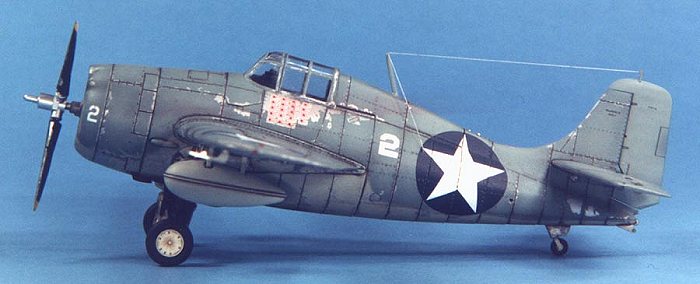
Tamiya 1/48 F4F-4 Wildcat
|
KIT # |
61034 |
|
PRICE: |
$23.00 |
|
DECALS: |
See review |
|
REVIEW & |
|
|
NOTES: |
Superscale decals used |

|
HISTORY |
Many American fliers served with distinction during WW2, but those that may have faced the harshest conditions were those pilots posted to the strategic island of Guadalcanal in the south Pacific. Code-named "Cactus" by the Americans, Guadalcanal was an important stepping-stone in the Japanese advance to isolate Australia from her allies and when the Japanese started construction on an airfield the order was given for American troops to invade and occupy the island. On August 7, 1942, U.S. Marines stormed ashore for the first Allied offensive of the young war. Shortly thereafter on August 20 after the airfield was completed by U.S. forces, the first Marine aviators of VMF-223 & 224 were posted to the island. Marion Carl of VMF-223 was one of the first of many Marine pilots to serve with distinction in the Guadalcanal campaign.
|
THE KIT |
The kit is Tamiya’s 1:48 Grumman F4F-4 Wildcat. The name Tamiya says it all with regards to quality, there are no better kits out there today (IMHO). This kit features approximately 50 injected molded plastic parts that are the envy of the business in quality, and decal options for four aircraft (generic aircraft for VF-41, VMF-223, VGF-29, & VF-22). The instruction sheet is an eight-page foldout diagram assembly with marked color painting guidelines using Tamiya paints.
|
CONSTRUCTION |
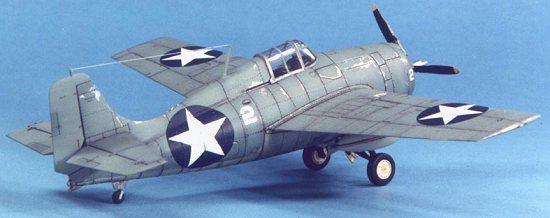 I started with my usual
warm, dish soap water wash of the plastic components, followed with a cold water
rinse. Pat dry with a paper towel and let dry overnight. I then pre-painted all
the parts as indicated in the instructions. For the interior color I used Polly
Scale US Interior Green A/N611. After detail painting a light burnt umber wash
was applied, and raised details were highlighted with a light dry brushing of
silver. Assembly of the cockpit/forward fuselage presented no challenges and
went together beautifully. The level of detail present in the cockpit is quite
good, although there are some minor accuracy problems especially regarding the
floor layout. However, if you are planning on leaving the canopy closed, this is
not readily apparent and an aftermarket resin cockpit is probably a waste of
money.
I started with my usual
warm, dish soap water wash of the plastic components, followed with a cold water
rinse. Pat dry with a paper towel and let dry overnight. I then pre-painted all
the parts as indicated in the instructions. For the interior color I used Polly
Scale US Interior Green A/N611. After detail painting a light burnt umber wash
was applied, and raised details were highlighted with a light dry brushing of
silver. Assembly of the cockpit/forward fuselage presented no challenges and
went together beautifully. The level of detail present in the cockpit is quite
good, although there are some minor accuracy problems especially regarding the
floor layout. However, if you are planning on leaving the canopy closed, this is
not readily apparent and an aftermarket resin cockpit is probably a waste of
money.
Assembly of the fuselage halves and wings was quick and easy, the seams lined up perfectly with no putty required and only minimal sanding to clean up the join lines. The cockpit assembly also installed beautifully with no problems. The engine assembly also presents no problems and after detail painting as called out in the instructions everything was given a light wash of Tamiya Smoke to really pop out the detail and the cooling fins. I then masked off the canopy and installed it with jewelers watch cement and gave the entire model a good wipe down with Pollys Plastic Prep to prepare the surfaces for painting. After stuffing wet tissue paper in the engine opening and wheel wells, it was off to the paint shop.
|
PAINT & DECALS |
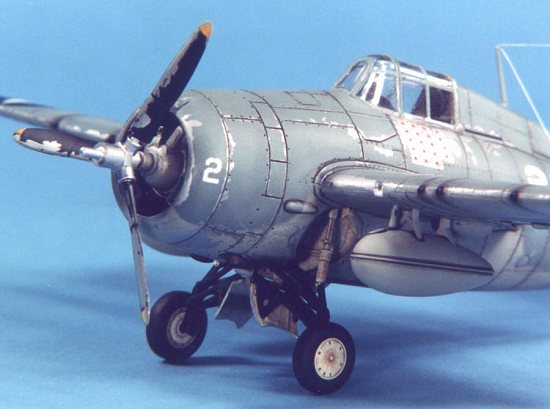 The paint scheme is very
simple, the early Navy colors of blue-gray over light gray undersurfaces. Since
I was planning on heavily weathering the model with paint chipping, I first
airbrushed a coat of Floquil Bright Silver. I then airbrushed Polly Scale USN
Blue Gray for the topside, and USN Light Gray A/N602 for the undersides. To fade
the topside colors due to the intense sunlight and harsh operating conditions I
mixed a 50:50 mix of Blue Gray and Dirty White thinned 50:50 with distilled
water and airbrushed the interior panels carefully. A light overall mist was
also airbrushed to provide for a general faded look. After letting the paint
cure overnight, I attacked the finish along panel lines using a blunt pair of
tweezers and tape to heavily chip the surface to expose the underlying silver. I
then airbrushed a light coat of Future to prepare the surface for decaling.
The paint scheme is very
simple, the early Navy colors of blue-gray over light gray undersurfaces. Since
I was planning on heavily weathering the model with paint chipping, I first
airbrushed a coat of Floquil Bright Silver. I then airbrushed Polly Scale USN
Blue Gray for the topside, and USN Light Gray A/N602 for the undersides. To fade
the topside colors due to the intense sunlight and harsh operating conditions I
mixed a 50:50 mix of Blue Gray and Dirty White thinned 50:50 with distilled
water and airbrushed the interior panels carefully. A light overall mist was
also airbrushed to provide for a general faded look. After letting the paint
cure overnight, I attacked the finish along panel lines using a blunt pair of
tweezers and tape to heavily chip the surface to expose the underlying silver. I
then airbrushed a light coat of Future to prepare the surface for decaling.
The decals supplied with the kit are typical Tamiya, but I had an old OOP Superscale sheet featuring Wildcat aces that I substituted. I chose the decal option for Marion Carl’s aircraft used in the Guadalcanal campaign. After drying overnight, I wiped the decals off with a moist cloth with Pollys Plastic Prep to remove any residue and after drying I shot a light coat of Future over the decals to seal them.
Next, a burnt umber oil wash was applied to the panel lines and after clean up a light coat of Polly S Flat Finish was shot to provide a surface for pastels. I then used pastels, and pastel pencils to lightly highlight the panel lines and detail on the wings/tail surfaces and fuselage. I use Derwent pastels and pencils and they are quite easy to use, just lightly draw on the surface to be highlighted and blend with artists blending stump. A very nice, subtle effect can be achieved with these pencils that is much easier for me than dry brushing or pre-shading. Next I applied a heavy burnt umber oil wash to the wheels and sealed everything with a light coat of Future.
|
CONSTRUCTION CONTINUES |
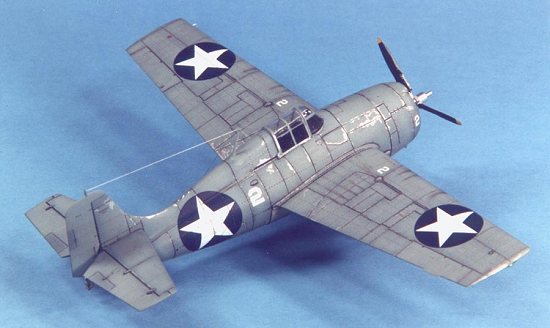 After painting and
weathering, I assembled the landing gear, propeller, the drop tanks, pitot, and
antenna mast. As usual, everything went together flawlessly. The only difficult
part of this kit are the wheel assemblies due to their intricate nature, but if
you closely follow the instructions there will be no problems and Tamiya is to
be commended for fantastic engineering of a very complex mechanism. Finally,
several coats of Polly S Flat Finish was shot to achieve a flat finish common to
aircraft operated in harsh conditions and then the remaining clear parts were
installed in place with white glue.
After painting and
weathering, I assembled the landing gear, propeller, the drop tanks, pitot, and
antenna mast. As usual, everything went together flawlessly. The only difficult
part of this kit are the wheel assemblies due to their intricate nature, but if
you closely follow the instructions there will be no problems and Tamiya is to
be commended for fantastic engineering of a very complex mechanism. Finally,
several coats of Polly S Flat Finish was shot to achieve a flat finish common to
aircraft operated in harsh conditions and then the remaining clear parts were
installed in place with white glue.
|
CONCLUSIONS |
Tamiya models are my absolute favorite to build, as they usually have no major problems to contend with. This kit was no exception, and not a single spot of filler was needed. This kit makes a beginner modeler look like an expert, is extremely easy to build, and is highly recommended. This kit is so easy; it’s almost ridiculous!
Ed note: I have a Combat vacuform that I would be more than willing to let you build if you want to stretch those modeling skills!
|
REFERENCES |
Squadron/Signal Publications, F4F Wildcat Walk Around, SS5504
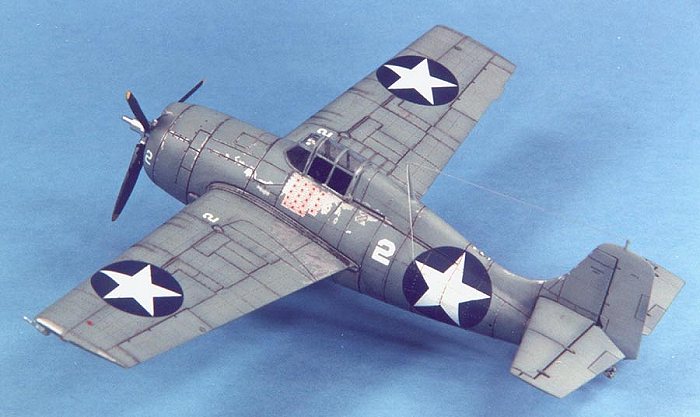
If you would like your product reviewed fairly and quickly, please contact me or see other details in the Note to Contributors.